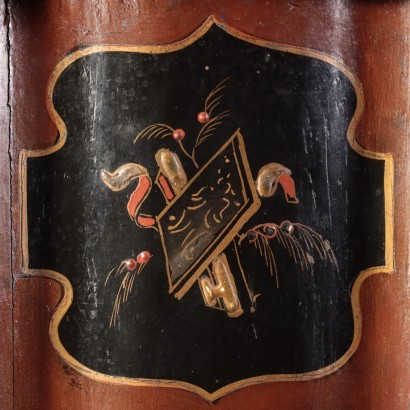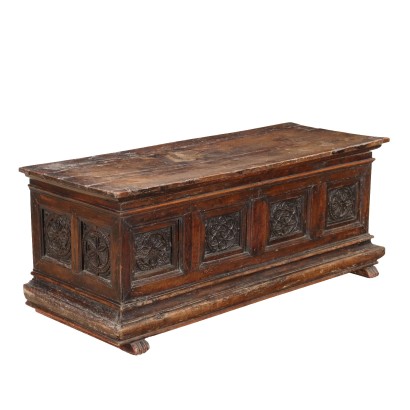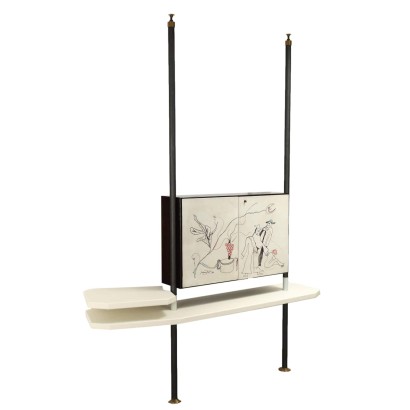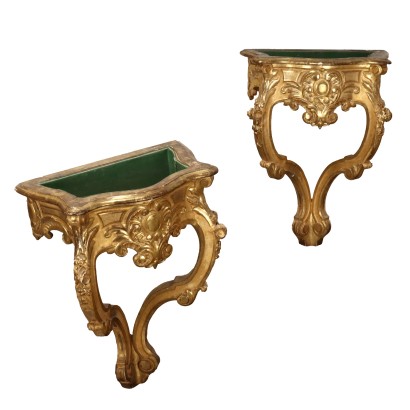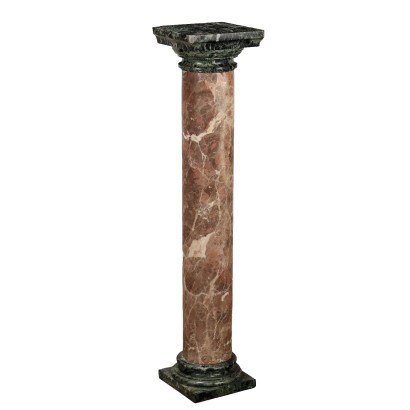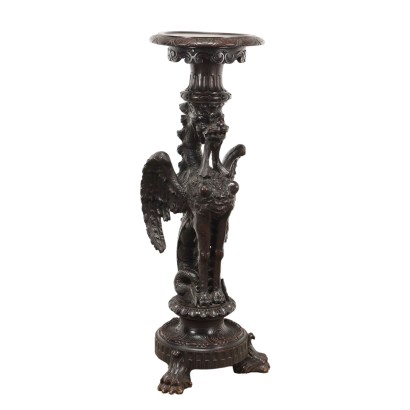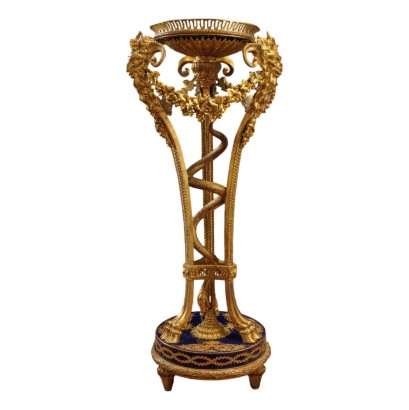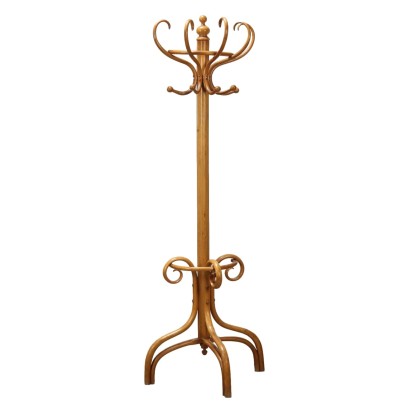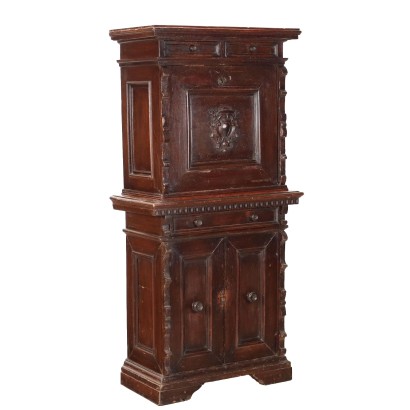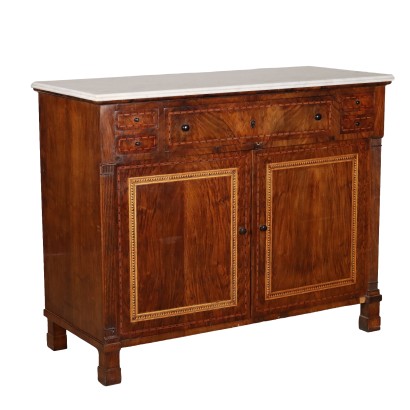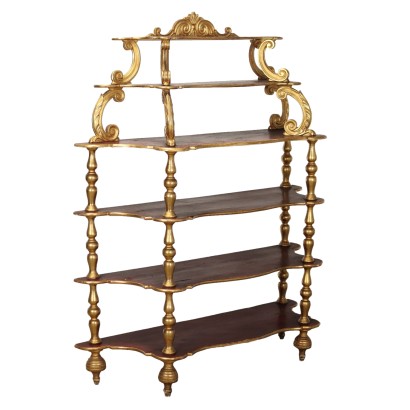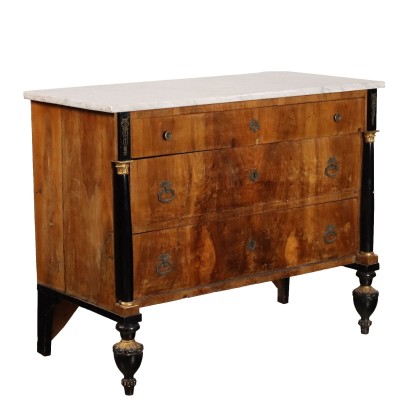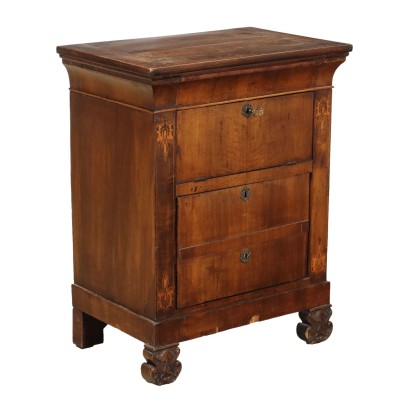Pair Of Vase Holding Columns Wood Italy Mid 19th Century
Features
Style: Chinoiserie (1600-1800)
Age: 19th Century / 1801 - 1900
Origin: Italy
Description
Pair of wooden vase holding columns, entirely lacquered in chinoiserie style. Shaped, the base has a tall painted plinth with red and black chequered reserves. On the four uprights, there are small tiles with a busy outline, they are decorated with floral motifs of oriental taste in the middle. On the four main sides there are bigger reserves, the middle ones are painted with oriental scenes: exotic plants with colourful birds, landscapes with pagodas, where aristocrats live, and palanquins carried by servants. On the top part, there is a small shaped and ebonized shelf.
Product Condition:
Fair condition. Wear consistent with age and use. Any damage or loss is displayed as completely as possible in the pictures. Product with a Certificate of Authenticity and Lawful Origin.
Dimensions (cm):
Height: 109,5
Diameter: 35,5
Certificate issued by: Enrico Sala, expert
Additional Information
Notes historical bibliographic
Chinoiserie objects and ornamental motifs established themselves throughout Europe in the eighteenth century, although they also spread widely during the following century. In a cultural moment generally characterized by a particular attention towards everything that was exotic, the revival of oriental art became a recurring factor. Therefore, objects and furnishings with wavy and shaped shapes spread, decorated taking up the technique of Chinese lacquering, with motifs that reproduce idealized images and scenes and considered representative of oriental culture.Style: Chinoiserie (1600-1800)
The term Chinoiserie (Chinoiserie) comes from French and refers to a period of European art, starting from the 17th century, in which there was a notable influence of Chinese art, also in the wake of a growing interest that Europe had developed for everything that was exotic, in general.This period was characterized by the use of fanciful images of an imaginary China, by asymmetry in formats and capricious contrasts of scale and by attempts to imitate Chinese porcelain as well as by the use of materials similar to lacquer.
Chinoiserie entered the European repertoire in the second half of the 17th century, when the work of Athanasius Kircher had a great influence on the study of Orientalism.
The popularity of chinoiserie reached its peak in the mid-18th century, when it was assimilated into the Rococo by the works of François Boucher.
They then declined when they appeared, in the eyes of Europeans, antithetical to neoclassicism.
They expressed themselves entirely in the decorative arts while their expression in architecture was realized entirely in the field of capricious "follies" (constructions made exclusively for decorative purposes, but whose form suggests another purpose).
On the other hand, the important transformations that Chinese models brought about in the 18th century on the style of early Georgian furniture and the naturalistic style of English garden landscapes were not considered chinoiserie.
Discover more about oriental influences in the history of the arts with our insights:
FineArt: Chinese mirror, last quarter of the 18th century
Oriental taste in late 19th century furnishings
The charm of the Orient in a Piedmontese manufacture
Presentation on FineArt of a Japanese armor of the 19th century
INSERT ADDITIONAL LINKS:
Oriental taste in Chinese and European furnishings
Oriental Art Collecting in the 18th Century
In-depth analysis of Oriental influences in European art
Age: 19th Century / 1801 - 1900
19th Century / 1801 - 1900Other customers have searched:
Altri mobili antichi, toilette antica, inginocchiatoio antico, baule antico, inginocchiatoio, mobili antiquariato, mobili antichi, bauli, cassapanca..
Se ti interessano i mobili d'antiquariato Scopri qui tutte le presentazioni dei prodotti d'antiquariato più belli, eleganti e preziosi su FineArt by Di Mano In Mano
Leggi di più
Sull'antiquariato in generale dai un'occhiata anche a:
Classic Monday: da un pezzo dei nostri magazzini alla storia dell'antiquariato
L'antiquariato dalla A alla Z: il Dizionario dell'Antiquariato
Il dizionario dell'antiquariato - Lastronatura
Il dizionario dell'antiquariato - Mascherone
Il dizionario dell'antiquariato - Natura morta
Il dizionario dell'antiquariato - Opificio
Il dizionario dell'antiquariato - Pastiglia
Il dizionario dell'antiquariato - Savonarola
Il dizionario dell'antiquariato - Rosone
Infine, dai un'occhiata alle nostre rubriche di divulgazione sulla storia delle arti decorative e d'arredo:
Epoche
Lavorazioni e tecniche
Mostre ed Eventi
Protagonisti
Leggi di più
Sull'antiquariato in generale dai un'occhiata anche a:Classic Monday: da un pezzo dei nostri magazzini alla storia dell'antiquariato
L'antiquariato dalla A alla Z: il Dizionario dell'Antiquariato
Il dizionario dell'antiquariato - Lastronatura
Il dizionario dell'antiquariato - Mascherone
Il dizionario dell'antiquariato - Natura morta
Il dizionario dell'antiquariato - Opificio
Il dizionario dell'antiquariato - Pastiglia
Il dizionario dell'antiquariato - Savonarola
Il dizionario dell'antiquariato - Rosone
Infine, dai un'occhiata alle nostre rubriche di divulgazione sulla storia delle arti decorative e d'arredo:
Epoche
Lavorazioni e tecniche
Mostre ed Eventi
Protagonisti
Product availability
The product can be seen at Cambiago
Immediate availability
Ready for delivery within 2 working days from ordering the product.




